With a history dating to 1520 AD, Biharwe Eclipse monument, the only Archaeoastronomy site in East and central Africa, is a pillar of history and a collection of historical bondings.
Unveiled by Yoweri Kaguta Museveni on 30 August 2014, the monument built and developed by the Igongo Cultural Center, is said to be the only scientifically dated event in the early history of the Great Lakes Region.
It is believed that its occurrence affected three kingdoms, namely; Bunyoro Kingdom, Buganda Kingdom and Nkore Kingdom.
Designed by Joseph Sematimba, a creative director and lecturer of art and design at Makerere University, the towering three-legged Biharwe Eclipse Monument is located at Biharwe hill, a few kilometers from Mbarara city.
The structure stands at about 30 metres high with a large orange orb suspended in perfectly circular space on the top.
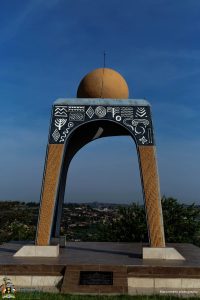
The Biharwe monument is designed and embedded with pictorials blue hag include drums, shields, spears, and other symbols that represent aspects of different cultures such as community values, lifestyles, beliefs, and tools that were used for different purposes.
These are derived from the patterns that were used on the traditional Hima huts.
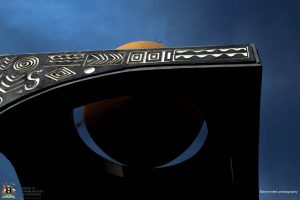
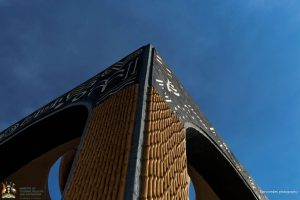 According to Kashule Moses, a guide at Igongo cultural lodge and center, the custodians and developers of the monument, the eclipse is an embodiment of three Kingdoms, namely; Bunyoro, Buganda, and Ankole.
According to Kashule Moses, a guide at Igongo cultural lodge and center, the custodians and developers of the monument, the eclipse is an embodiment of three Kingdoms, namely; Bunyoro, Buganda, and Ankole.
It is said on his way back to his kingdom, Bunyoro King Olimi I Rwitamahanga and his soldiers were forced to abandon all his loot which included cows, women, and slaves that he had looted from Rwanda during the reign of Umwami Ruganzu II Ndori.
Kashule says that the king and his soldiers were surprised to see day time darkening and in awe, they abandoned everything at the current station hosting the monument.
He says that the loot that was left behind was inherited by Ntare I Nyabugarobwera who was the king of Nkore at that time.
“The cows were named “Empenda ya Munoni” and “Enduga Mwiguru”, which are translated as “cows from heaven”. Some legends have it that because he could not go back to his kingdom empty-handed, Olimi I Rwitamahanga chose to invade Buganda kingdom under the reign of Ssekabaka Nakibinge. During the battle in Bulemezi, Ssekabaka Nakibinge and his commander Kibuuka were killed after Kibuuka’s Munyoro concubine betrayed him. Nakibinge was succeeded by his son Mulondo,” said.
Features:
The three pillars
The three pillars on the monument represent the three kings (Olimi, Ntare, and Nakibinge) who were affected directly by the Biharwe eclipse.
The fourth pillar was not added as this symbolised the instability amongst the kingdoms that is the cattle raids, famine, and tribal wars of that era.
The globe / Sphere
The sphere represents the moon that is uniformly offset along a circular void on top to create a ring void that surrounds the base of the globe.
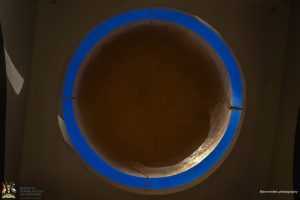
The gap was designed to simulate the eclipse with its shadow on the ground as long as there is sunshine.
The simulation is a transforming shadow that is cast at the base of the monument that keeps evolving from a crest shape shadow in the morning sunrise to a ring-shape shadow at mid-day and finally to a fading crest shadow at sunset.
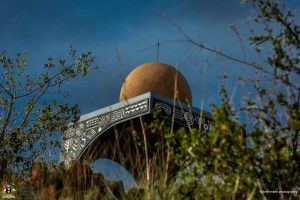 The pictorials and symbols on the surface
The pictorials and symbols on the surface
A number of sculptures and artworks, are at the Buharwe eclipse these representing the history of Nkore culture.
Bunyoro Kingdom pillar and it’s involvement
It is believed that the King of Babiito Dynasty of Bunyoro Kitara Kingdom, Olimi I, at the time of the eclipse also referred to as Rwitamahanga (destroyer of nations) by many Bantu groups of the Great Lakes Region, was returning home from their usual expeditions in Rwanda, Karagwe, Mpororo and Nkore kingdoms when the eclipse took place.
Kashule says the king had looted cattle in thousands and killed hundreds of people in the process.
He had captured women and children whom he had turn into slaves and concubines at home.
He adds that King Olimi had reached the hilly village of Biharwe in present day Mbarara city when all of a sudden the face of the sky darkened in the middle of the day.
“In the king’s head, the gods of the people he had offended were conspiring to finish him. And so in repentance or fear or both, the king and his party fled making sure to leave everything behind,” Kashule narrates.
Ankole Kingdom
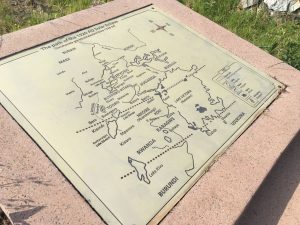 The guide revealed that the King of Nkore saw the same event differently.
The guide revealed that the King of Nkore saw the same event differently.
Prior to the eclipse, his kingdom had been going through tough times, caused by loots, death of almost all the cattle due to diseases, followed by poverty and starvation.
He says that during the hard times, the society, had started using wild berries for bride price due to lack of cattle.
This treacherous era is still engraved in folklore as obujuganyoonza – the days when wild berries were accepted for bride price.
So when King Olimi I fled leaving all those cattle and everything else behind, it was seen by the king and his people as an act of benevolence from the gods.
Those cows would come to be known as endugamwiguru, meaning ‘the cows that came from heaven’.
For the ancient Kingdom of Nkore, the eclipse had sparked the beginning of a period of untold prosperity for the king and his people.
How it affected Buganda
Just like the Nkole people, those in Buganda Kingdom also saw the eclipse and not long after the dark day, they heard of the misfortunes of King Olimi.
These thought the great King of Bunyoro had been deserted by his gods. The King of Buganda thought that the King of Bunyoro was weakened for it was believed that in normal circumstances, the King of Nkore would never have defeated King Olimi I.
Having been humiliated in battle by King Olimi I on many occasions, King Nakibinge of Buganda, thought this was his cue to take revenge.
However, the battle did not go well, he would get the shock of his life when he found out that the Biharwe eclipse had nothing to do with King Olimi I being deserted by his gods.
The Buganda army was defeated and the king killed in battle.
Route to the monument.

The monument is along the Masaka- Mbarara highway at Biharwe, a few kilometers from Mbarara City. It can be accessed by road or hiking.
However, to experience the adventure, hiking is the best option, the ways during a hike are three, all painted blue, red and green.
These present the kings and Kingdoms that were involved at the time the eclipse happened.
The blue represents Ankole Kingdom. The Red represents Bunyoro Kingdom and is named after the Bunyoro King. The Yellow route represents the Buganda Kingdom, and is also named after the then King of Buganda, King Nakibinge.
To access the site, for Nationals, one has to part with Shs 10,000 and for foreigners, one will pay USD10.
photos by the ministry of Tourism and Marvin Miles.









